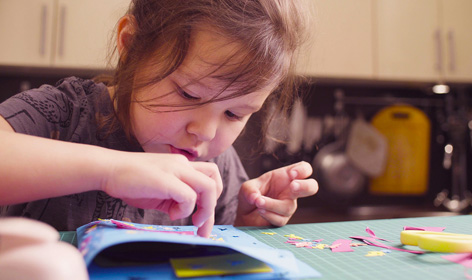by Donna Foster •

If I were to ask you to tell me about your life, where would you start?
Would it be the time you broke your arm in a car accident when you were 17? Or the time your family moved, leaving your grandparents and friends behind? You were only eight years old then and you felt so unhappy and alone. Maybe you would cry telling me how one of your brothers died from an illness and your family lost their meaning in life. You may have many difficult and painful memories that bring you sadness.
Or would you talk about your dad smiling and clapping when you sang in school chorus? Or about making a new best friend when you moved to a new neighborhood? How many fun and silly stories do you have about playing with your sister and brothers? Or how you felt everything was OK in the world when you cuddled in your mother’s lap. Her arms always made you feel safe.
A life book is essential in helping a child who has experienced trauma. And all children in foster care have experienced trauma.
We need good, warm stories to balance the difficult times in our lives. And when we forget, we need those who were there to remind us of them.
Children in foster care have their stories. Which ones do you think stand out for them about entering foster care? Probably the painful memories come to mind. Going into foster care is traumatic.
So how do you help them recall their good, warm, loving memories? Even in chaos there are happy moments worth holding on to. How do you help the child keep those moments close by when times are hard?
By keeping them safe in a life book.
A Child’s Life Book
A child’s life book holds their stories, memories, hopes, and dreams. It holds the happy and the sad because it is their truth—their life. The people to help document these things are his foster parents, his social worker, and his birth parents. To make the life book richer, the other important people in his life can share memories with him. Stories and photos from siblings, grandparents, teachers, and others can prove to the child he is special to many people.
A life book is essential in helping a child who has experienced trauma. And all children in foster care have experienced trauma.
If you fill up one book, you continue with another. One of the children I fostered left us with three life books and huge plastic containers full of his special belongings, including items he brought from his birth home.
More than a Photo Album
A life book is more than a photo album. A life book is a binder filled with preprinted pages to fill out or pages children can design themselves. It holds a child’s memories: mementos, photos, drawings, journals. Every photo should have a written story to describe who was there, where it was taken, when it was taken and any special memories or feelings tied to it. The child uses his life book to record his history and the goals for his future.
The life book is a tool that helps the child to process all the big events throughout his lifetime. It may begin when the child moved into his foster home, but the story it tells should start with his birth. Creating it should be an ongoing process.
The life book belongs to the child. He decides who can look at it. When the child moves, the book goes with him.
Connection to Shared Parenting
Take advantage of all the opportunities to create the child’s life book. Visits can be made richer with the sharing of stories and photos. Foster parents can give to birth parents copies of photos taken of their child so they can share in his milestones. This encourages the birth parents and the child.
Another benefit is that life books can help create a healthy relationship between birth parents and foster parents. Just imagine how the child feels when he is sitting between his birth and foster parents as they help create pages together. The foster parent or the social worker can bring the accessories to make life book pages.
In the past when I shared photos with the birth parent, the birth parent or grandparents brought photos of when the child was home. I copied them to use in the life book and gave the originals back to the family. Seeing their family photos and stories in the child’s life book proved to the birth family that the foster family was including them in their child’s life. Life books can be a wonderful tool to support shared parenting.
Life Books Ease Transitions
Are you seeing the big picture? We need to think “outside the box” and be creative in meeting children’s needs. One of the foster parents’ jobs is helping children transition into and out of foster care. Life books can show the child they don’t have to lose their past in order to gain their future.
What better way to help the child than to record their journey in a life book? Children benefit tremendously when they can open up a book and view their life and those who love them. Really, we all could benefit from having our own life book.
Life books can be wonderful tool to support shared parenting.
Another benefit for the foster family when working on the child’s life book with the birth parent is the birth parent will feel the foster parent’s support. If birth parents are convinced of this, when the child goes home, the foster family could remain part of the child’s life.
Don’t forget to include your life with the child in the book so he will have his memories with you. When the child is preparing to leave, a letter from the foster family expressing their ongoing love for the child and his family makes the move home easier. A group photo with both families speaks volumes!
Reunification is usually the plan, but if something changes and the child is freed for adoption, can you see the gem in having a life book? It answers the child’s questions of “who am I?” and “was I loved?” Plus, adoptive parents can continue the child’s journey with their own life book stories and photos. If he is not adopted by his foster parents, it would lessen the trauma of leaving his foster home if his foster family is encouraged to remain in the child’s life. The overlapping of families feels more like a continuum of life instead of a loss of meaningful relationships. This is how children need us to love them.
Want to be remembered as someone who cares deeply for the child? Create a life book with the child that shows your commitment to his well-being. Enjoy the process!
Donna Foster is the author of “Shelby and Me: Our Journey through Life Books,” a national trainer, and a consultant who lives in Marshville, NC.
* * * * * *
Supplies for Creating Life Books
Put scrapbooking supplies on your agency’s “wish list” so the community can donate or create a project for life books. Many items below can be found in craft, department, dollar, and office supply stores.
Binders: Use one with a clear sleeve you can slide a title page into. A 3-inch binder holds a lot of pages. If a binder becomes full, buy another. The binder color should reflect the child’s taste. Binders that hold 8½” x 11” paper are easiest to find and use.
Scrapbooks: A popular size is 12” x 12”. If you select this size, use 12” x 12” paper.
Colored paper and card stock (acid-free, lignin-free): Use any scraps left over to add dimension to scrapbook pages.
White paper and card stock (acid-free, lignin-free): Can be used for general pages or to share stories to place on darker pages.
Pens, markers, pencils (acid-free): Needed to write stories, notes, and captions around photos. Acid-free is a must so the ink does not fade. Black is a staple (sets with .25mm-.45mm are helpful for a change in print size) Colored pens are good for writing and drawing.
Lettering (acid-free, lignin-free): An old stand-by that come in all color and sizes. Children like to have their names on their pages.
Stamps/stamp pads: Stamping is fun. The proper acid-free ink is mostly found in craft stores and some department stores. When stamping, you can go further by coloring in the ink design with special pens, etc.
Stickers (acid-free, lignin-free): Available for all occasions and themes, stickers are fun to use and can dress up any life book page.
Die-cuts (acid-free, lignin-free): Stick these card stock shapes (squares, ovals, etc.) to your pages. You can buy them separately or buy a large tool that cuts different shapes.
Paper trimmer: Trimmers cut your paper in a straight line and are easy to use.
Sharp scissors: Worth the cost. You will be cutting small angles and other scrapbooking items.
Adhesives (acid-free): There are several types of glues (liquid, non-wrinkling, acid-free, glue sticks, glue pens, glue paste) as well as double-sided tape (squares, dots, cut-as-you-go).
Corner punch: Curves photo corners. Very handy.
Ultra ShapeXpress Starter Set by Fiskars: Cuts shapes and borders quickly and easily.
Life keepsake boxes: Not all keepsakes can be stored in a binder. Having plastic containers to store larger or extra items gives more options for storing. Just a reminder, children who have experienced losses may either collect and save everything or not keep anything for fear the items will be taken from them. Giving the child control over their possessions is vital. It is OK for adults to store away things they feel the child will miss in his later years.
* * * * * *
Lifebooks: Samples and Sources
Here are just a few of the resources available to help you create a lifebook.
The Child’s Own Story: Life Story Work with Traumatized Children by Richard Rose and Terry Philpot (Jessica Kingsley Publishers, 2005). Available from: www.jkp.com.
Making History: A Social Worker’s Guide to Lifebooks by Joann Harrison, Elaine Campbell, Penny Chumbley (2010). Available from: https://bit.ly/2VGz7XH.
Lifebook Pages from the Iowa Foster and Adoptive Parents Association. Available from: www.ifapa.org/publications/ifapa_lifebook_pages.asp.
My Foster Care Journey by Beth O’Malley (2001). Available from: www.adoptionlifebooks.com
My Awesome Life by Lutheran Social Services of Illinois. Available from: https://www.lssi.org/SUPPORT/MyAwesomeLife.aspx.
Shelby and Me: Our Journey through Life Books, by Donna Foster. Available by emailing [email protected].


